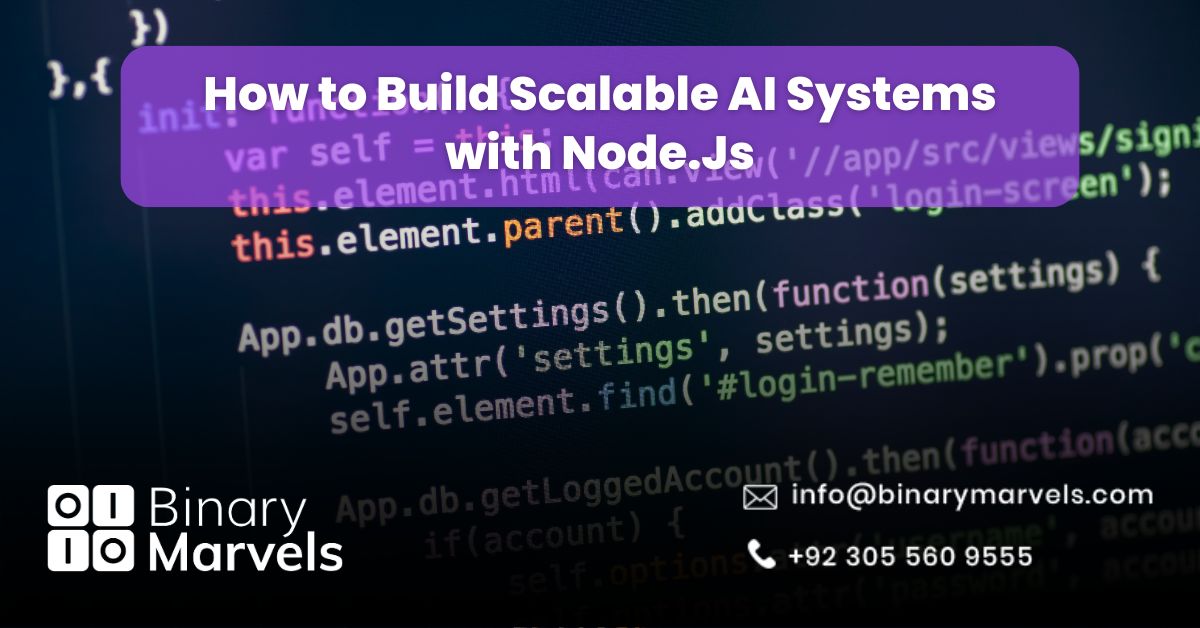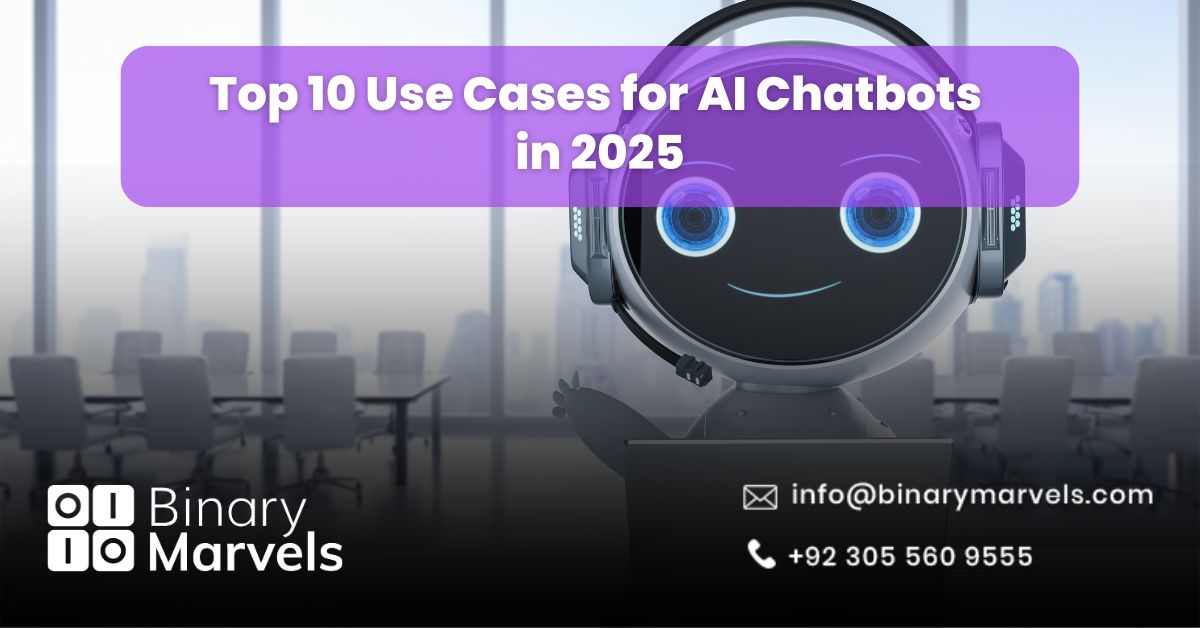
Can you really build scalable AI systems with Node.js?
Absolutely. In 2025, it’s more practical than ever.
Node.js isn’t just for lightweight APIs anymore. Thanks to a growing ecosystem of AI and machine learning libraries, improved performance with Node.js 20+, and modern DevOps workflows, developers are now building real-time, scalable AI applications entirely in JavaScript. From chatbots and recommendation engines to voice assistants and fraud detection systems, Node.js offers the speed, flexibility, and scalability that AI-driven platforms demand.
In this guide, you’ll learn how to build scalable AI systems with Node.js step by step. We’ll cover key frameworks, architecture patterns, deployment strategies, and how to overcome the challenges of scaling AI on the web.
Why Use Node.js for Scalable AI Systems in 2025
Node.js has evolved into more than just a backend runtime for simple applications. Its event-driven, non-blocking architecture makes it a powerful choice for AI systems that demand real-time processing, low latency, and high throughput. In 2025, the ecosystem around Node.js has matured with tools and libraries that make building and scaling AI applications faster and more efficient.
Here’s why Node.js stands out for AI development
High Performance with V8 Engine
Node.js runs on the lightning-fast V8 engine, offering excellent performance for both computation-heavy tasks and rapid I/O operations.
Unified Language Stack
Developers can build the frontend, backend, and AI logic all in JavaScript or TypeScript, reducing context switching and speeding up development cycles.
Massive Ecosystem
With npm, you gain access to thousands of AI, machine learning, and data processing packages that can integrate seamlessly with your Node.js app.
Real-Time Capabilities
Node.js excels in scenarios like real-time inference, streaming data, and dynamic content generation, which are ideal for AI-powered features like live chat, voice input, or anomaly detection.
Cloud-Native and Scalable
Node.js works exceptionally well with microservices, serverless platforms, and containerized deployments. This allows your AI system to scale horizontally as demand grows.
By choosing Node.js, you’re setting the foundation for an AI system that is not only scalable but also fast, flexible, and ready for future expansion.
Also Read: Voicebot vs Callbot vs AI Voice Agent: Key Differences Explained
Core Principles of Scalability in AI Systems
Building an AI system that works is one thing. Building one that scales efficiently across users, regions, and data volumes is another. Scalability ensures your application performs reliably under growing demand, which is especially critical for AI use cases like real-time analytics, recommendation engines, and dynamic decision-making.
Here are the key principles to keep in mind when designing scalable AI systems with Node.js
Stateless Microservices
Breaking your application into stateless services allows independent scaling, fault isolation, and easier deployment using containers or serverless functions.
Event-Driven Architecture
Node.js is ideal for event-based workflows. Using tools like RabbitMQ, Kafka, or Redis Streams helps manage asynchronous communication between services and model components.
Containerization and Orchestration
Docker and Kubernetes simplify deployment and scaling. You can manage services, automate rollouts, and scale AI workloads dynamically based on traffic or compute demand.
Model Offloading to GPUs or TPUs
Heavy AI models can be served separately using platforms like TensorFlow Serving or ONNX Runtime. Node.js interacts with these services via REST or gRPC for fast inference.
Autoscaling and Load Balancing
Use cloud-native features like Kubernetes Horizontal Pod Autoscaler (HPA) or AWS Application Load Balancer to adjust resources automatically and maintain performance under load.
Monitoring and Observability
Track metrics like response time, CPU usage, and inference latency using tools such as Prometheus, Grafana, and Elastic APM. This helps you optimize bottlenecks before they impact users.
Mastering these scalability principles ensures that your Node.js-based AI system is reliable, efficient, and ready to support rapid business growth.
Top Node.js Libraries and Frameworks for AI and Machine Learning in 2025
Node.js now supports a wide variety of libraries for AI and machine learning, making it a strong platform for building intelligent applications in JavaScript. Whether you need neural networks, computer vision, natural language processing, or deep learning, there’s a tool for every use case.
Below are some of the most powerful and actively maintained Node.js libraries for AI in 2025
TensorFlow.js
A JavaScript version of TensorFlow that allows you to train and run machine learning models directly in the browser or on the server with Node.js. It supports both CPU and WebGL acceleration.
Brain.js
A simple yet effective library for neural networks. It supports feedforward networks, recurrent networks, and LSTM models, and is great for tasks like pattern recognition and time series forecasting.
Synaptic
A lightweight and flexible neural network library for Node.js. Synaptic gives you full control over building and training custom architectures without much overhead.
ML5.js
Built on top of TensorFlow.js, ML5.js offers an easy-to-use interface for developers who want to integrate pre-trained models without digging into complex machine learning code.
ONNX Runtime for Node.js
Run models trained in any framework like PyTorch or TensorFlow using the ONNX format. This allows high-performance inference on a variety of platforms using a single interface.
Natural and NLP.js
These libraries are ideal for building chatbots, text classifiers, and other natural language processing tools directly within your Node.js application.
LangChain.js
A newer addition for those building AI agents and working with large language models. It enables chaining prompts, memory, retrieval, and external APIs together for advanced AI behavior.
With these libraries, developers can create, train, and deploy machine learning models entirely within the Node.js ecosystem, making it easier to build full-stack AI applications that scale.
Also Read: 8 Keys When Choosing an AI Vendor for Your Business
Building AI-Powered Web Applications with Node.js: A Step-by-Step Guide
To build a scalable AI system with Node.js, it’s essential to follow a structured development process. Below is a simplified yet complete walkthrough that takes your idea from concept to production.
1. Define Your Application Idea
Start by outlining the problem your AI app will solve. Define the target users, the input data, the expected output, and how AI will add value. Be clear about what makes the application intelligent.
2. Set Up the Environment
Install Node.js (preferably the latest LTS version), TypeScript if needed, and set up a package manager like npm or yarn. Use a version manager like nvm to easily manage Node versions.
3. Select the Right AI Framework
Choose a library based on your use case. Use TensorFlow.js for deep learning, Brain.js for lightweight neural networks, or Natural for NLP. Ensure it integrates well with your Node.js stack.
4. Design the Application Architecture
Plan how the components will communicate. Consider using microservices, message queues, and REST or GraphQL APIs. Make your architecture scalable by separating model logic from business logic.
5. Train Your AI Model
Either train your model in Node.js using a library like TensorFlow.js or use a pre-trained model. If using external tools like Python or Jupyter notebooks, export the model in a format like ONNX for Node.js compatibility.
6. Integrate the Model
Add your trained model to the application. This might be a local integration or a remote call to an AI service. Use proper abstraction so you can swap or update models easily.
7. Test and Debug
Write unit and integration tests to validate your model outputs, API endpoints, and data flow. Use logging and monitoring tools to track performance and detect errors in real time.
8. Deploy Your Application
Use Docker to containerize your Node.js app. Deploy on cloud platforms like AWS, GCP, or Azure using Kubernetes or serverless options. Automate deployment with CI/CD tools like GitHub Actions.
9. Optimize and Scale
Profile your application to find bottlenecks. Use clustering, worker threads, or load balancing to handle higher traffic. Apply caching strategies for repeated AI predictions and optimize infrastructure costs.
Following this step-by-step approach helps you build AI-powered applications that are not only functional but production-ready and scalable from day one.
Also Read: Top 10 AI Companies in Pakistan
Why Choose JavaScript Over Python for AI Web Applications
Python has long dominated the AI and machine learning landscape, but JavaScript—powered by Node.js—is becoming a serious contender for web-based AI development. For teams focused on building scalable, full-stack AI applications, JavaScript offers several unique advantages.
Full-Stack Development in One Language
With JavaScript, developers can handle both frontend and backend logic without switching languages. This improves productivity, simplifies project architecture, and reduces communication overhead between teams.
Real-Time Capabilities
Node.js excels at handling asynchronous events and real-time data streams, making it perfect for AI features like live chat, predictive input, and personalized recommendations.
Massive Developer Community
JavaScript has one of the largest global developer communities. This means more support, faster updates, and a rich ecosystem of tools, plugins, and documentation.
Browser Compatibility with TensorFlow.js
Unlike Python, JavaScript allows you to run models directly in the browser. This opens up new possibilities for edge AI, offline inference, and privacy-focused applications.
Easier to Deploy for Web-First Projects
If your target platform is the web, JavaScript and Node.js eliminate the need to translate Python code or deal with backend/frontend mismatches.
While Python remains a strong choice for deep learning research and heavy model training, JavaScript is an excellent alternative for teams focused on deploying scalable, real-time AI applications in production environments.
Also Read: AI Voice Agents for Customer Service: Benefits, Use Cases & Best Practices
Frequently Asked Questions
Is Node.js good for AI and machine learning web apps?
Yes, Node.js is increasingly used in AI-powered web applications, especially when real-time performance, scalability, and full-stack JavaScript development are required. While it may not replace Python for model training, Node.js is highly effective for deploying and integrating AI models into production systems.
What Node.js libraries are best for machine learning?
Some of the most popular and reliable libraries include TensorFlow.js, Brain.js, Synaptic, ML5.js, and ONNX Runtime. Each library has different strengths, such as deep learning, neural networks, or compatibility with pre-trained models.
What are the performance benefits of using Node.js for AI?
Node.js is lightweight, fast, and non-blocking, making it ideal for handling concurrent AI requests, real-time inference, and streaming data. Its event-driven nature and support for worker threads also help manage compute-intensive tasks efficiently.
Can Node.js handle real-time AI data processing?
Yes, Node.js excels at processing real-time data streams through technologies like WebSockets, Kafka, and message queues. This makes it ideal for use cases like live chatbots, fraud detection, and recommendation engines.
How does Node.js compare to Python for building AI web apps?
Python is preferred for training large models and research, but Node.js is better for deploying AI to the web. With the rise of TensorFlow.js and other libraries, Node.js allows developers to run inference, manage APIs, and scale AI apps with ease, entirely in JavaScript.
Supercharge Your Business with AI Today!
As a trusted AI Development Company in Pakistan, we deliver cutting-edge AI Development Services designed to streamline your operations and enhance customer engagement.
Don’t wait—connect with us now and take your business to the next level!
Conclusion
Building AI systems is no longer reserved for researchers or data scientists. With the right tools and strategies, you can build scalable AI systems with Node.js that are fast, reliable, and production-ready. From real-time chatbots to predictive engines and intelligent automation, Node.js provides a powerful foundation to bring AI into your web applications.
In this guide, you’ve explored the key frameworks, architecture patterns, development workflows, and deployment practices needed to scale AI successfully in 2025. Whether you’re a solo developer or leading a team, Node.js allows you to create AI-powered solutions that adapt to user needs, handle large data streams, and grow with your business.









